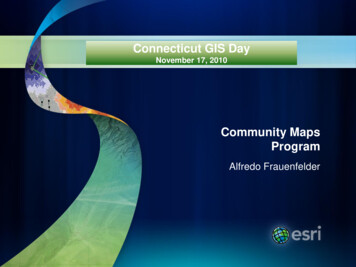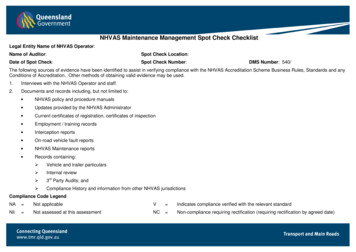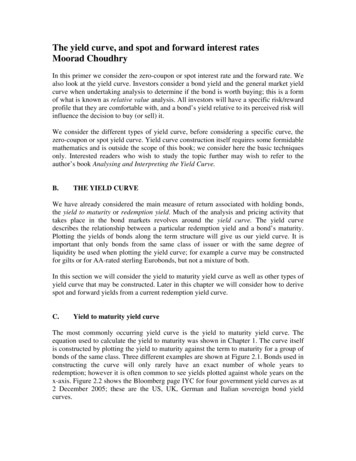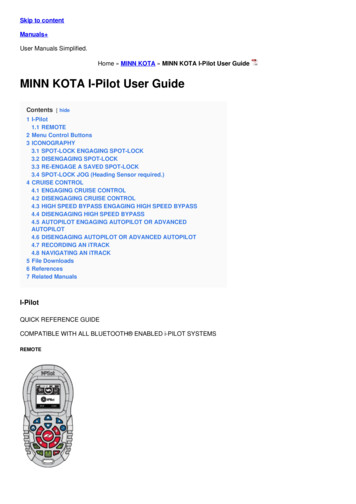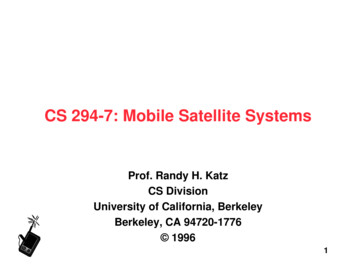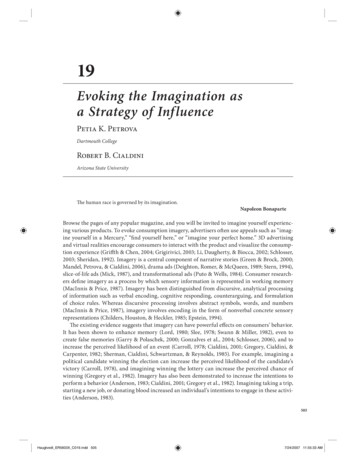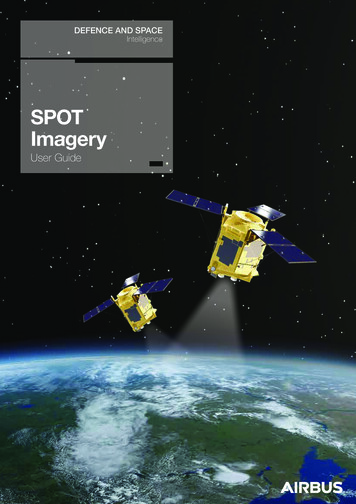
Transcription
DEFENCE AND SPACEIntelligenceSPOTImageryUser Guide
iiSPOT Imagery User GuideOrganisation of theSPOT 6 & SPOT 7 ImageryUser GuideThe SPOT 6 & SPOT 7 Imagery User Guide providesessential information to the users about all SPOT 6products and services.The document is divided into four main parts, followed bytechnical appendices. Chapter 1 details the SPOT 6/7 constellation and itsperformance. Chapter 2 explains the SPOT 6 / SPOT 7 productsoffer. Chapter 3 details product ordering options. Chapter 4 presents product delivery.For the experienced users, Technical Appendices completethe document by covering the following points:A. DIMAP V2 formatB. Image quality performanceC. Geometric modelingD. Spectral modelingWe would like this document to be as useful aspossible. If you feel that information is missing orunclear, or for any feedback you may have on the contentand format, please send an email to:technicalsupport@intelligence-airbusds.com
ContentsContents1 The Airbus Defence and spaceOptical Constellation3 Product Ordering3.1 Access to SPOT 6 and SPOT 7 Products153.2 How to Order?161.1 Reactivity and Rapid Coverage Capacity31.2 Acquisition Capacity33.2.1GeoStore153.2.2Ordering Through Customer Service161.2.1Swath and Coverage31.2.2Single Pass Collection Scenarios– Overview4Stereoscopic Cover Capabilities41.2.352.1.1Get Access to Premium Archive Imagery52.1.2One Tasking62.2 Spectral Band l112.3.3Bundle112.3.4Pan-sharpened112.3 Processing Level334 Product delivery2 Products, Services and Options2.1 Reliable and Immediate Access3.3 Order Cancellation, Order Modification,Terms and Conditions122.3.1Primary product .122.3.2Standard Ortho132.3.3Tailored Ortho132.4 Products and Image Format132.5 Licensing144.1 Order Completion and Delivery344.2 Deliverable354.2.1Overview of the Product354.2.2Example364.3 How to Open Your Product374.4 Technical Support and Claims37iii
ivSPOT Imagery User GuideAppendix A: File Format – DIMAP V2A.1 File and Folder Naming38C.1 Geometry55A.1.1 Naming Conventions38C.1.1 Focal place55A.1.2 Tree Structure41C.1.2 Primary product geometrical properties55A.2 Levels of Informationand File Short ContentsA.3Appendix C: Geometric ModellingC.1.3 Ortho product geometrical properties 5743A.2.1 The Dataset Packaging Root Level43A.2.2 The Pass Acquisitions Level43A.2.3 The Acquisition Level43A.2.4 The Spectral Imagery Product Level44A.2.5 Sub-Levels WithAdditional Information46Metadata Contents and Organization48A.4 Image Format48A.4.1 JPEG 200048A.4.2 TIFF48A.4.3 Raster file Band Index48A.4.4 Image Tiling49A.5 Available Geographic and CartographicProjectionsC.2 Using the Physical Model for the PrimaryProductsC.2.1 Direct Localization:Image to the Ground5859C.2.2 Inverse Localization: Ground to Image 62C.3 Using the Analytical Model or the RationalPolynomial Coefficient (RPC) Model63C.3.1 Direct Localization Algorithm63C.3.2 Inverse Localization Algorithm64C.4 Other Informative Geometric Data64C.4.1 Acquisition Angles64C.4.2 Solar Angles65C.4.3 Ground Sample Distance (GSD)6550Appendix D: Spectral ModelingA.5.1 Geographic Projections50A.5.2 Mapping Projections50D.1 SPOT 6 Spectral Bands66A.6 How to georeference the image?51D.2 Spectral Sensitivity of the SPOT 6 Sensor66A.6.1 GMLJP251D.3 Converting Digital Count to TOA Radiance67A.6.2 GeoTIFF Tags51D.4 TOA Spectral Reflectance67A.6.3 World File51Abbreviations, Acronyms and Terms68Table of Symbols and Values Locationin DIMAP V273Document Control and Data Sheet77Appendix B: Image Quality andB.1 Design Specification vs. Performances53
ContentsList of figuresFigure. 1:Pléiades 1A/1B and SPOT 6/7 constellationFigure 1.1a:SPOT 6 (blue) and SPOT 7 (green) combinedcorridor of visibility on a given day ( /- 30 )31Figure 1.1b:Tasking areas3Figure 1.2.2:Single pass collection scenarios4Figure 1.2.3:Stereoscopic cover capabilities overmountainous areas4Selection of SPOT archive in GeoStoreproduct filters5Reliable and Immediate Access:5Figure 2.1:2.1 Figure 2.1.1a: GeoStore homepage to accessSPOT 6 and SPOT 7 imageryFigure 2.1.1b: Selection of SPOT 6 and SPOT 7 archive inGeoStore product filters66Figure 2.2.1:Example of a panchromatic image11Figure 2.2.2:Example of a multispectral image11Figure 2.2.3:Example of a bundle product11Figure 2.2.4:Pan-sharpened process11Figure 2.3.1:Perfect sensor geometry12Figure 3.2.1a: GeoStore – research interface15Figure3.2.1b: GeoStore - browsing archive catalog16Figure 3.2.2a: Front cover of the Pléiades & SPOTData Request Form16Figure 3.2.2b: Page 2 of the Pléiades & SPOTData Request Form17Figure 3.2.2c: Page 3 of the Pléiades & SPOTData Request Form19Figure 4.1b:Figure 4.2:Figure 4.2.1:GeoStore order management page– map view34Product tilingIf a product is not tiled,the file name is: ‘product R1C1.JP2’35Dimap v2 structure35Figure 4.2.2a: example of dimap v2 structure36Figure 4.2.2b: kmz preview, footprint36Figure 4.2.2c: kmz preview, bubble36Figure 4.2.2d: kmz preview, layers36Figure A.2.4.4: kmz overview46Figure A.4.4:49tiling (below)Figure C.1.1a: Full focal plane layout (swath)and location of primary virtual array.55Figure C.2.2b: Raw focal plane layout and locationof primary virtual array55Figure C.1.2.2: Primary bundle grids alignment57Figure C.1.3.2: Ortho bundle grids alignment58Figure C.2a:Image focal plane frame58Figure C.2b:Geocentric earth frame (WGS84)58Figure C.2c:Frames summary59Figure C.2.1a: Viewing angle in image focal plane frame59Figure C.2.1b: Find the point on the groundat the right altitude H61Figure C.4a:Relation between incidence angleand viewing angle64Figure C.4b:Satellite azimuth angle65Figure C.4c:incidence angle projected on two planes65Figure 3.2.2d: Pages 4 and 5 of the Pléiades & SPOTData Request Form22Figure C.4d:Viewing angle along and across track65Figure 3.2.2e: Acquisition failure terms23Figure C.4e:Solar incidences65Figure 3.2.2f: Illustration of B/H Ratio27Figure D.2:Figure 3.2.2g: Illustration of B/H Ratio and hidden items27Spectral normalized sensitivitiesof SPOT 6 sensors66Figure F1:Stereoscopic – B/H68Figure F2:A control moment gyro68Figure F3:DEM vs. DTM68Figure F4:IFOV and GSD69Figure F5:Pushbroom sensor71Figure F6:Viewing angle72Figure 3.2.2h: Extract from page 6 of the Pléiades & SPOTData Request Form featuringProcessing Options32Figure 3.2.2i:Figure 4.1a:Example of an 8-bit product without linearadjustment (top) and with linearadjustment (bottom).33GeoStore order management page– list view34v
viSPOT Imagery User GuideList of tablesTable 1a:Table 1b:Table 1c:Table 1d:Table 1.1:Main characteristicsof the Space System2Orbital characteristicsand viewing capability2Main characteristics of the SPOT 6and SPOT 7 optical instruments2Table A.2a: Overview of available informationvs. Processing levels43Table A.2b: Metadata organization45Table A.2d: KML Metadata File46Table A.2e: Datastrip source metadata file47Table A.2f:47Ground Source metadata fleMain characteristics of the SPOT 6/7ground segment2Table A.2g: Processing metadata File47Revisit capacity3Table A.4:Raster file index for default rgb display48Table A.5:Map projections50Table 1.2.3: Stereo / Tristereo acquisition capacitiesaccording to b/h4Table 2.1a: Overview of One Tasking options8Table A.6a: Georeferencing51Table 3A.6b: Projected or Ortho Worldfile52Table A.6c: Primary Worldfile5210Table B:Specifications and performance54Table 2.3:Geometric details of the Ortho product 13Table C:GSD vs viewing angle56Table 2.4:Image format options14Table D:SPOT 6 spectral bands66Table 4.1:Delivery time34Table T1:Approx mapscale equivalenciesbased on US NMAS68DTED Classes69Table 2.1b: One Tasking specifications extractedfrom the dedicated document,One Tasking Specifications.Table 4.2a: Examples of file size35Table T2:Table 4.2b: number of image files and ofbands per product type35Table A.1a: Naming - prefixes38Table A.1b: Naming - suffixes39Table A.1c: Naming - main directories39Table A.1d: Naming - extensions39Table A.1e: Naming – spectral processing40Table A.1f:40Naming – processing levels
Contentsvii
Chapter 1: SPOT Constellation1 The Airbus Defence andspace Optical ConstellationPléiades 1AWith four satellites - Pléiades 1A & 1B and SPOT 6 & SPOT7 – launched in a two-year timeframe, Airbus Defence andSpace Services is offering its customers the very best ofspace technology.Ensuring continuity of Earth optical imaging service upto 2024, these satellites operate in a true constellation,combining a twice-daily revisit capability with an ingeniousrange of resolutions.SPOT 7SPOT 6Pléiades 1BFigure 1: Pléiades 1A/1B and SPOT 6/7 constellationThe Pléiades twins are very high-resolution satellitesdelivering 50-cm Ortho products as a standard. SPOT 6and SPOT 7 are designed to extend SPOT 5’s success tothe 1.5 m product family. Phased on the same orbit, theconstellation enjoys unprecedented reactivity, with sameday revisit capacity anywhere on the Earth. Multiple taskingplans per day result in an unrivalled optimization of datacollection: unforeseen weather changes, as well as lastminute requests, can be taken into account for a first-classlevel of service.SPOT 6 and SPOT 7 satellites imagery offer an affordablesource of information for analysing, monitoring, forecastingand managing resources and human activity on ourplanet. SPOT products are true decisionsupport toolsfor a large range of applications such as civil and militarymapping, natural and man-made disaster management,natural resource exploration, land planning, crop andforestry monitoring, environmental protection and maritimesurveillance.1
2SPOT Imagery User GuideFollowing tables outline the main characteristics of the SPOT 6/7 space and ground systems.Number of satellites2Launch periodsSPOT 6: September 9th, 2012Optical systemOne instrument made of 2 identicalKorsch telescopes, each with a200mm aperture, delivering theexpected swath.DetectorsPAN array assembly: 28,000 pixelsSPOT 7: June 30th, 2014Design lifetimeMinimum of 10 yearsSizeBody: 1.55 x 1.75 x 2.7 mSolar array wingspan 5,4 m2Launch mass712 kgAltitude694 kmOnboard storage1 Tbits end of life(Solid State Mass Memory)Table 1a: Main characteristics of the Space SystemSPOT 6 and SPOT 7 missions are designed to achieveefficiently both collection of large coverage and collection ofindividual targets that are possible thanks to the extremeagility of the satellite.Spectral bands(specification)Pan: 455-744nmBlue: 454-519 nmGreen: 527-587 nmRed: 624-694 nmNear-IR: 756-880 nmThe 5 bands are always acquiredsimultaneously.Swath60km at nadirDynamic range atacquisition12 bits per pixelLocation accuracyspecification 35m CE 90 without GCP within a 30 viewing angle cone 10m CE90 for Ortho products whereReference3D is availableOrbitSun-synchronous; 10:00 AM localtime at descending node,26-day cycle, 694-km altitudePeriod98.79 minutesCycle26 daysGound samplingdistance (nadir)Panchromatic: 2m; Multispectral: 8mProduct resolutionPanchromatic1.5m; Multispectral: 6mMain receivingstations Toulouse (France)Swath60 km at nadir Kiruna (Sweden)Viewing angleStandard: /- 30 in roll Extended: /- 45 in rollS-Band uplinkstationsProgramming centreRevisit 1 day with SPOT 6 and SPOT 7operating simultaneouslyAirbus Defence and Space Service –Toulouse (France) Between 1 and 3 days with only onesatellite in operation1Pointing agilityAcquisition capacityControl Moment Gyroscopes allowingquick maneuvers in all directions fortargeting several areas of interest onthe same pass (30 in 14s, includingstabilization time)Up to 6 million sq.km daily withSPOT 6 and SPOT 7 when operatingsimultaneouslyNominal imagingmode60km-swath strips oriented alongNorth-South axis; up to 600km lengthStereo capabilitySingle pass stereo and tri-stereo(Fore, nadir and aft mode)Table 1b: Orbital characteristics and viewing capability1MS array assembly: 4 x 7000 pixelsDepends on the latitude of the area of interestInstrumenttelemetry link rateX-band channel - 300 Mbits/sTable 1c: Main characteristics of the SPOT 6 and SPOT 7 opticalinstruments Kiruna (Sweden) Inuvik (Canada)Airbus Defence and Space Service –Chantilly VA (USA)Production centreAirbus Defence and Space Service –Toulouse (France)Tasking plans refreshfrequency6 times/day/satelliteUpdate of weatherforecast4 times/day – fully automatic processSatellite controlcentreAirbus Defence and Space Satellite –Toulouse (France)Table 1d: Main characteristics of the SPOT 6/7 ground segment
Chapter 1: SPOT Constellation1.1 Reactivity and Rapid CoverageCapacitySPOT 6/7 constellation is composed of two twin satellitesoperating as a true constellation on the same orbit andphased 180 from each other. Added to their obliqueviewing capability (up to 45 angle) and exceptional agility,this orbit phasing allows the satellites to revisit any point onthe globe daily - ideal for anticipating risks, managing criseseffectively or speed up large areas coverage.These multiple mission plans per day enable handling oflast-minute tasking requests as well as integration of thelatest worldwide weather forecast, for an improved datacollection success rate.The phased orbit of the constellation’s satellites offers up todaily revisit capacity:Viewing angleSPOT 6 orSPOT 7 onlySPOT 6 andSPOT 7 5 degrees26 days13 days 20 degrees7 days4 daysFigure 1.1b: Tasking areas 30 degrees5 days2 days 45 degrees2 days1 daySPOT 6 and SPOT 7 satellites provide exactly the samecoherent and high quality products. Tasking plans arenatively optimized between the two satellites to fullyleverage the synergies between the twins.Table 1.1: Revisit capacityFor the user, this results in: More images collection opportunities Unprecedented capacity for disaster response, regularmonitoring, or change detection Rapid coverage of areas of interest1.2 Acquisition CapacityFigure 1.1a: SPOT 6 (blue) and SPOT 7 (green) combined corridorof visibility on a given day ( /- 30 )SPOT 6/7 constellation has an impressive acquisitioncapacity of 6 million square kilometres per day. In additionthe time needed to slew from one tasking request toanother is reduced thanks to the agility of the systemsand the successful acquisition rate is increased with theintegration of frequent updates of weather forecasts.1.2.1 Swath and CoverageThe daily revisit capacity is backed by a reactive operationalloop: mission plans are updated every 4 hours.Two polar uplink stations are used to optimize the upload ofwork plans.They are located in: Kiruna (Sweden) – upload of two mission plans daily Inuvik (Canada) – upload of four mission plans dailyThe swath of 60 km, already available on previous SPOTmissions, has been maintained on SPOT 6 and SPOT 7.SPOT 6 and SPOT 7 have been especially design to coverlarge areas in a shortest timeframe, therefore in nominalacquisition mode, the satellites acquired long strips, up to600 km long.This results in maximized information on a target and itssurroundings, optimized production with diminished needfor cutlines and mosaicking work over large areas, as wellas easier data handling, with fewer folders and products tomanipulate for a given large AOI.3
4SPOT Imagery User Guide1.2.2 Single Pass Collection Scenarios – OverviewSPOT 6 and SPOT 7 mission takes benefits from thehigh agility of the satellite to offer efficient data collectioncapabilities making them particularly suitable to servecartographic and monitoring applications.1.2.3 Stereoscopic Cover 5km0.335km0.260 km0.460 km0.3120 km0.590 km0.4180km0.6120 km0.5240km0.7150 km0.6300km0.8180 kmTable 1.2.3: Stereo / Tristereo acquisition capacities according to b/h1 Standard datacollection: Long strip2 Standard data collection:TargetStandard data collection mode enables to acquire in one pass(a) North-South long strip of up to 600 km length. In addition, thehigh satellite agility allows (b) very quick moves from one scene toanother along an orbit. This provides a high efficiency to complete,in the shortest time, global data coverage over a large area ofinterest, allow acquisition conflicts avoidance and makes possiblethe collection of number of distant targets in a given geographicalarea in a single pass.Tristereo images can be used to create more accurate3D models than can be done with basic Stereo, as thenear nadir acquisition minimizes the risk of missing hiddenitems. It is prescribed for dense urban and mountainousareas - Figure 1.2.3. Please refer to 3.2.2 (step 5) for moreinformation about B/H.3 Single passMulti-stripcollection4 Single passCorridorcollectionSPOT 6 and SPOT 7 are able to acquire (c) contiguous imagesegments collected from a single pass along one orbit. Thisprovides capability to cover areas of more than 240 km x 120 kmor 180 km x 180 km in a single pass. Corridor acquisition (nonNorth-South oriented) allows rapid covering of certain areas in aneffective way (e.g. rivers, borders )Figure 1.2.2: Single pass collection scenariosFigure 1.2.3: Stereoscopic cover capabilities over mountainousareas
Chapter 2: Products, Services and Options2 Products, Services and OptionsSPOT 6 and SPOT 7 products can be easily integrated inGIS environment or used to derive thematic geoinformationwhile combined with other satellite, airborne or groundinformation.SPOT 6 and SPOT 7 instruments always acquire imagessimultaneously in both modes:Panchromatic and Multispectral bands are co-registered(completely superimposable).SPOT 6 and SPOT 7 offera wide range of products and services, featuring differentoptions to match as close as possible any customer’srequirement. Panchromatic: one band (black and white). Multispectral: four bands (colour).Figure 2.1: Selection of SPOT archive in GeoStore product filters2.1 Reliable and Immediate Access:An Image When and WhereYou Need It2.1.1 Get Access to Premium Archive ImagerySince May 1986, more than 100 billion square kilometersof Earth surface have been covered by SPOT successivemissions on a daily basis.Once acquired and displayed in our catalogues, theseimages constitute the SPOT 6/7 archive, and are ready forimmediate order. Users can search the archive via ore-orderingFigure 2.1.1a: GeoStore homepage to access SPOT 6 and SPOT 7 imagery5
6SPOT Imagery User GuideFigure 2.1.1b: Selection of SPOT 6 and SPOT 7 archive in GeoStore product filtersFor any questions related to GeoStore,please do not hesitate to contact GeoStore team:Intelligence-geostore@airbus.comIn order to gain up-to-date information on what is currentlyhappening on the ground, a customer can also request theacquisition of a new image.2.1.2 One Tasking: Committed toDelivering ImageryCommissioning a satellite and obtaining the imagery yourequested – exactly when you need it – is now risk-free,fast, and incredibly easy.30 years ago, Airbus DS Intelligence was the first to offersatellite-tasking services, revolutionising the satellite imagerymarket. Today, with One Tasking, the company sets the baragain, with an unprecedented commitment to deliver newimagery collections when and where its customers need them.In a context of information overload, with One Tasking,Airbus DS Intelligence offers a unique and different offer onthe market. It takes full advantage of its satellite resourceavailability and the true daily revisit capabilities of itssatellite constellations, in order to collect and deliver – withunrivalled reliability – the image or coverage you requested,exactly when you need it.Airbus DS Intelligence’s programming offer, redesignedfrom the ground up, is committed to delivering the verybest results, instead of the industry’s typical ‘best effort’approach, with a tasking service designed entirely aroundthe customer’s needs.2.1.2.1 A Matter of Satellites, Talent andDedicationBoth genuine satellite constellations, SPOT and Pléiades,share the same orbit and tasking plan. They behave as asingle flexible satellite gifted with true daily revisit capabilities– maximising collection success rate and coverage speed.In addition, a team of world-class tasking experts ensuresthat your area is covered on time and on spec. Airbus DSIntelligence’s team carefully conducts feasibility studiesand closely follows up open tasking requests, constantlyadjusting priorities. All of that fine-tuning is in Airbus DSIntelligence’s DNA and, more than any technical feature, isthe secret of One Tasking’s reliability.One Tasking provides you with answers and support inany situation: from the most basic map update through toemergency response, not to mention land-use analysis,mission planning, and frequent insights through reliablemonitoring.
Chapter 2: Products, Services and OptionsKey benefits Best choice for maximising the success of yourcollection campaign. Streamlined offer, to lighten the ordering processfor all satellites and sales channels. Financial compensation, if (ever) we do notmake it on time. 24/7 access. Flexible sensors, superior availability for ultra fast deliveryOne Tasking offers four tasking options:Pick the Right Product for Your NeedsChoose your acquisition dayAccess useful information in an instantImagery acquisition for a specific day is now risk-free.When immediate imagery is required, our satellites can24 hours before your acquisition date, you receive abe tasked to deliver valuable insights in the shortestweather forecast to let you confirm, postpone or cancelpossible timeframe. Don’t panic if it’s cloudy – we keepyour request at no cost.collecting images of your area until we are successful.Obtain qualified coverage within anagreed timeframeGet cowverage on a regular basisWhether you are dealing with long-term changes orYou select your timeframes, dates and preferred sensorhighly dynamic situations, OneSeries brings you the– we ensure you receive the right qualified coverage,required intelligence at the frequency you choose.perfectly matching your project milestones.For highest frequencies, our cloud cover commitmentensures you pay only for the most useful results.7
8SPOT Imagery User GuidePick the RightProduct forYour NeedsChoose youracquisition dayImagery acquisition fora specific day is nowrisk-free. 24 hoursbefore your acquisitiondate, you receive aweather forecast to letyou confirm, postponeor cancel your requestat no cost.Access usefulinformation in aninstantObtain qualifiedcoverage within anagreed timeframeWhen immediate imageryis required, our satellitescan be tasked to delivervaluable insights inthe shortest possibletimeframe. Don’t panicif it’s cloudy – we keepcollecting images ofyour area until weare successful.You select yourtimeframes, dates andpreferred sensor – weensure you receive theright qualified coverage,perfectly matching yourproject milestones.Get coverage on aregular basisWhether you are dealingwith long‑term changes orhighly dynamic situations,OneSeries brings you therequired intelligence at thefrequency you choose. Forhighest frequencies, ourcloud cover commitmentensures you pay only for themost useful results.Timeframe1 dayThe smallest periodneeded to secure threeacquisitions – additionalacquisitions are madeuntil cloud cover ratereaches 10% or thecustomer decides to endthe taskingCustomer selectedCloud Cover 100% 10%. All acquisitionsare delivered. A validatedacquisition ends thetasking 10% or 5% with uplift Possibility to select three small cloud-free AOIs(Pléiades 1x1 km, SPOT 3x3 km) For OneSeries Critical, 10% or 100% in case of dailyacquisition; in this case, images are invoiced whenreaching at least 40% cloud freeMin AOI Pléiades: 100 km² SPOT: 500 km² Pléiades: 100 km² SPOT: 500 km² Pléiades: 100 km² SPOT: 500 km²Max AOIPléiades: 20 km EW x 40 km NSSPOT: 60 km EW x 120 km NSBigger areas are subject to feasibility studyAcquisitionModeMono (Stereo andTristereo subject tofeasibility study)Mono, Stereo or TristereoMono(Stereo and Tristereo submitted to feasibility study)IncidenceAngle*0–52 ( 30 on customerselection)0–52 ( 30 on customerselection) OnePlan and OneSeries Routine:0–30 or customerselected OneSeries Critical: 0–52 or 30 on customer selectionB/HCustomer selected for all options or per default: Stereo 0.4–0.7 /Tristereo 0.2–0.35 between each pairService LevelPremiumAcquisitionFailure Terms25% voucher on thevalue of the missedacquisitionIf one acquisition ismissing from the threefirsts, the other twoacquisitions will bedelivered at no charge.OneNow with weatherforecast consideration: 25%voucher of the missingacquisition valueCustomer selected,including frequency Pléiades: 100–50 km² iffive revisits or more SPOT: 500–250 km² iffive revisits or moreSubject to feasibility studyRegularRegular/Premium10% voucher on the fullorder value OneSeries Routine:10% voucher of the valueof the missed acquisition OneSeries Critical:25% voucher of the valueof the missed acquisitionTable 2.1a: Overview of One Tasking options* The official way to display angles in Airbus DS Intelligence's offering is based on the incidence angle. This is applicable to all documentsand ordering forms/tools. For customers requesting viewing angle conversion, a tool which enables dynamic conversion has been set upon our website.
Chapter 2: Products, Services and Options2.1.2.2 Cloud Cover WarrantyOptimising SPOT 6 and SPOT 7 satellite tasking inaccordance with weather forecasts three times a dayensures that all resources are used as efficiently as possible.We propose image tasking with cloud cover less than10% or 5% over the Area Of Interest (AOI) of the order.Depending on the area of interest, we can guarantee smallcloud-free zones, typically three areas of 1 x 1 km within theinitial AOI. Cloud cover does not include cloud shadow orsemi-transparency haze.2.1.2.3 VouchersIn the event of a non-successful acquisition, as defined ineach offer, the customer is entitled to receive a voucher inconsideration of such a failure.A voucher is valid for three months from the end ofthe acquisition period. It can be redeemed against anyAirbus DS Intelligence product through GeoStore only.The customer must redeem the voucher, i.e. it is notautomatically deducted from the customer’s next order.Once the voucher has been used, it expires. The vouchercan only be spent in full; it cannot be split across severalorders. If the voucher is used for an order where the amountis less than the voucher value, the unused balance of thevoucher is lost. The voucher is considered as a meansof payment; it should be made visible on the invoice andapplied to the overall amount of the order, once potentialdiscounts and reductions have been applied. Eachvoucher is linked to a customer account and the vouchernotification is sent via email to the customer who placedthe failed order. The overall view of vouchers attached toone customer account is not available externally. For moreinformation on vouchers, please contact your usual point ofcontact: Airbus DS Intelligence Customer Care.2.1.2.4 Feasibility StudyThe feasibility study is a diagnosis performed by taskingexperts in order to organise the acquisition plan andestimate the confidence in covering the area of interestwithin the defined acquisition period and parameters. Toassess feasibility analysis, we ask the customer: where,by when and for which application. With this information,the Tasking Team issues a tasking proposal that includesadvice and recommendations that clearly indicate: The feasibility study diagnosis: feasible/difficult/verydifficult The estimated area coverage: % New proposed parameters when relevant.The feasibility study proposes the best programmingparameters in order to successfully collect the area ontime and on specifications (basis of our commitment andphilosophy of One Tasking offer). However, the customerwill always have the choice to select one tasking proposalor another. OneNow feasibility study mainly focuses on: OneNow : the first three days when the area can beentirely collected after the desired start date : the desired timeframe (7 daysmaximum), compared to the location, the size,the angle and cloud constraints.In both cases, the feasibility study indicates theincidence angle. For OneNow orders placed through GeoStore orCustomer Care, it is possible to filter access foracquisitions with an incidence angle of 30 or less – thusdisplaying the new acquisition days able to entirely coverthe AOI with the reduced angle. No choice is given onthe acquisition days. OnePlan and OneSeries feasibility studies mainly focuson the desired timeframe compared to the location,the size, the angle and cloud constraints. Dependingon all requested programming parameters, the TaskingManager issues a diagnosis (feasible, difficult, and verydifficult) to the customer and proposes alternatives if thefeasibility results are ‘very difficult’ or ‘difficult’. If the request is judged unachievable, the TaskingManager sends two proposals: one for it to become‘challenging’, one for it to become ‘achievable’ –each with the relevant quotations. If the request is judged to be difficult (challenging),the Tasking Manager sends two feasibility studies,each with the relevant quotation: one withchallenging parameters to match the customer’srequest, and another with different parameters thatwill make the tasking easy (achievable) to complete.The customer will always have the choice between bothtasking proposals.Early diagnostic for tasking orders submitted onlineWhen an order is submitted online via the web portal,the Early Diagnostic section provides customers withautomated early diagnostics with regards to the desiredtimeframe and specified location, size, angle and cloudconstraints. If the automatic diagnosis says your taskingcan be easily completed (achievable), it is activatedautomatically and the new collection is delivered (alsoautomatically) after acquisitions. However, if there arespecific tasking parameters, the Tasking Team confirmsthe feasibility and issues a Tas
Figure 1.1a: SPOT 6 (blue) and SPOT 7 (green) combined corridor of visibility on a given day ( /- 30 ) 3 Figure 1.1b: 3Tasking areas Figure 1.2.2: 4Single pass collection scenarios Figure 1.2.3: Stereoscopic cover capabilities over mountainous areas 4 Figure 2.1: Selection of SPOT archive in GeoStore 5product filters
